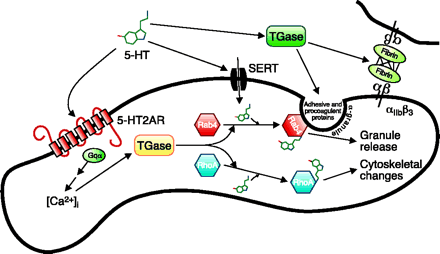
- Institution: Stanford Univ Med Ctr Lane Med Lib/Periodical Dept/Rm L109
- Sign In as Member / Individual
Platelet Activation and “Crossover Appeal”: Rab and Rho Families United by Common Links to Serotonin

Serotonin pathways leading to α-granule exocytosis. Serotonin (5-HT) is actively imported into platelets by the serotonin transporter (SERT) and stored in dense granules. 5-HT-mediated stimulation of the 5-HT receptor (5-HT2AR) results in a rise in intracellular calcium [Ca2+]i. Transglutaminase (TGase) is activated by Ca2+ and utilizes 5-HT to transamidate RhoA or Rab4, rendering them constitutively active by blocking GTP hydrolysis. Activation of RhoA and Rab4 leads to cytoskeletal rearrangements and α-granule exocytosis, respectively. Proaggregatory factors released from a-granules include von Willebrand factor (vWf), Factor V, and fibrinogen, all of which have been shown to be substrates for transamidation. Transamidation of these proaggregatory factors with 5-HT enhances their adhesive properties, localizing these factors to the activated platelet membrane where they then participate in further platelet activation events. Extracellular TGase, (Factor XIIIa) also cross-links fibrin bound to its receptor α11bβ3 which stabilizes the newly-formed platelet plug.


